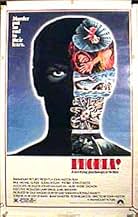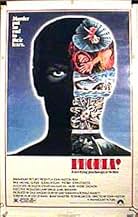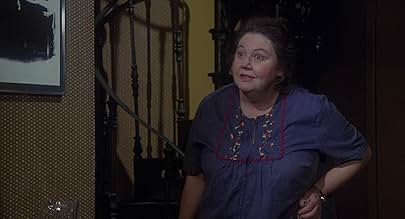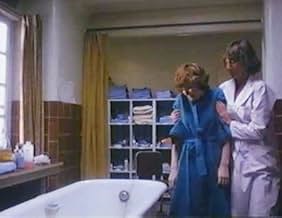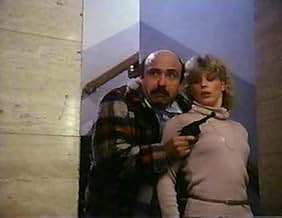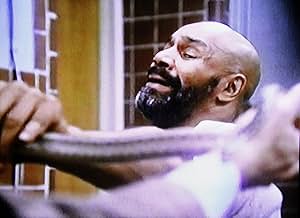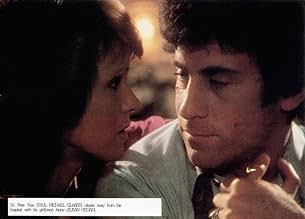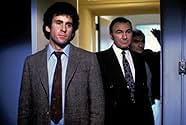IMDb-BEWERTUNG
4,3/10
940
IHRE BEWERTUNG
Füge eine Handlung in deiner Sprache hinzuA psychiatrist involved in a radical new therapy comes under suspicion when his patients are murdered, each according to their individual phobias.A psychiatrist involved in a radical new therapy comes under suspicion when his patients are murdered, each according to their individual phobias.A psychiatrist involved in a radical new therapy comes under suspicion when his patients are murdered, each according to their individual phobias.
- Auszeichnungen
- 2 Nominierungen insgesamt
John Stoneham Sr.
- Security Guard
- (as John Stoneham)
Empfohlene Bewertungen
Paul Michael "Starsky" Glaser is Dr. Peter Ross in this routine psycho-thriller, which is treated as *just* a pay check movie for the majority of the talent assembled. Certainly nobody brings any real passion or creativity to this script. The script is really not so hot, which is too bad considering that some of the writing talent involved included Ronald Shusett ("Alien") and Hammer scribe Jimmy Sangster ("Horror of Dracula"). Overall, the film is lacking in suspense and a truly good story, although the idea of mental patients led to their doom through their own phobias *could* have been better realized.
Ross is overseeing a program in which his patients are forced to confront images capturing their anxieties (heights, snakes, etc.). Then, one of them is blown to kingdom come by an explosive device left inside Ross' own apartment, and this leads to a rash of murders as the cops on the case (John Colicos, "The Changeling", and Kenneth Welsh, "The Day After Tomorrow") cast a suspicious eye on everyone in the therapy group.
Glaser is miscast in the lead and not very good, although the presence of Colicos & Welsh, and the appealing Susan Hogan ("The Brood") as Ross' girlfriend does help matters. Colicos and Welsh play "bad cops" who go out of their way to intimidate the nebbishy Henry (David Bolt, "Videodrome"). Co-starring are Patricia Collins ("Lost and Found"), David Eisner and Lisa Langlois from "Happy Birthday to Me", Robert O'Ree (David Cronenbergs' "Rabid"), Alexandra Stewart ("Frantic"), Neil Vipond ("Kings and Desperate Men"), and Marian Waldman (Mrs. Mac in the original "Black Christmas").
All of this is adequately entertaining at best, leading to a supposed "twist" ending that isn't exactly hard to figure out. Even this finale is executed with a certain lack of zeal.
There *are* worse thrillers out there, to be sure, but people may wonder why Huston would spend (some would say waste) his time filming such a script. At least his name in the credits ensures a definite curiosity value.
Five out of 10.
Ross is overseeing a program in which his patients are forced to confront images capturing their anxieties (heights, snakes, etc.). Then, one of them is blown to kingdom come by an explosive device left inside Ross' own apartment, and this leads to a rash of murders as the cops on the case (John Colicos, "The Changeling", and Kenneth Welsh, "The Day After Tomorrow") cast a suspicious eye on everyone in the therapy group.
Glaser is miscast in the lead and not very good, although the presence of Colicos & Welsh, and the appealing Susan Hogan ("The Brood") as Ross' girlfriend does help matters. Colicos and Welsh play "bad cops" who go out of their way to intimidate the nebbishy Henry (David Bolt, "Videodrome"). Co-starring are Patricia Collins ("Lost and Found"), David Eisner and Lisa Langlois from "Happy Birthday to Me", Robert O'Ree (David Cronenbergs' "Rabid"), Alexandra Stewart ("Frantic"), Neil Vipond ("Kings and Desperate Men"), and Marian Waldman (Mrs. Mac in the original "Black Christmas").
All of this is adequately entertaining at best, leading to a supposed "twist" ending that isn't exactly hard to figure out. Even this finale is executed with a certain lack of zeal.
There *are* worse thrillers out there, to be sure, but people may wonder why Huston would spend (some would say waste) his time filming such a script. At least his name in the credits ensures a definite curiosity value.
Five out of 10.
1980's "Phobia" earned the dubious distinction of being the single worst film in the lauded career of screenwriter/director John Huston, a simple work for hire that he apparently had little affinity or enthusiasm for (shot in October 1979 at the same time as another "Phobia" that finally emerged as "The Nesting," starring John Carradine). Location filming in Toronto even included something of a car chase, though it barely lasted three minutes and concluded with the driver falling to his death from a high girder. With five credited authors (a total of eight!), the promising storyline showed obvious signs of too many cooks spoiling the brew, its most fatal mistake playing out as a whodunit where the culprit was painfully obvious from the start. Hammer great Jimmy Sangster ("The Curse of Frankenstein") was essentially played out in feature films, now working entirely in Hollywood television, while the team of Dan O'Bannon and Ronald Shusett, coming off the massive hit "Alien," had their version of an original draft rejected by Huston (their next film was "Dead and Buried," faring better though still no box office success). Topping the cast list is Paul Michael Glaser, one half of the TV cop duo STARSKY & HUTCH, whose smug and detached Peter Ross is a ladies man and a renowned psychiatrist, whose latest endeavor is trying to help five convicted criminals conquer their greatest phobias; Alexandra Stewart has a fear of crowds, David Bolt a fear of high places, Robert O'Ree ("Rabid") a fear of snakes, David Eisner a fear of tight spaces, and pretty Lisa Langlois a not uncommon apprehension about the opposite sex. For all the backstory about how much people admire him, Ross comes off as a real cold fish, and once his patients start to get killed off he utterly fails to show any compassion, let alone remorse. John Colicos as the thuggish police inspector proves rather ineffectual, barking up the wrong tree as he forces one suspect to turn tail and commit suicide. Light on horror and suspense, this extremely minor effort was quickly forgotten and unlamented by all, particularly its director, who went from Canadian horror to full blown Hollywood musical with his successful adaptation of "Annie!"
Fear of something is called a "phobia". This movie takes it to a whole new level. Paul Michael Glaser, fresh off "Starsky & Hutch" plays a psychiatrist, who uses a new method to treat his patients with certain fears. When they get the treatment, they would try to conquer their fears, one step at a time. However, they would end up dead. They would have their own fears used against them. The victims aren't innocent. They are criminals. John Huston is known for his work. This movie may not have been a big hit, but I respect the fact that he is a very good man behind the stuff he does. There's no need for putting down the movie. It could be a cult classic one day. I can guarantee you that! It could have added more intrigue though.
2 out of 5 stars
During the 1970s, it was not an uncommon sight to have maverick Hollywood director John Huston slumming it out as an actor in often desperate, generic and star-studded international productions like TENTACLES (1977; whose fairly recent viewing did no favors to my childhood memories of it) and THE VISITOR (1979; which, surprisingly, turned out to be a far more satisfying watch than I could have ever imagined); this he did, no doubt, to obtain finance for the more personal of his projects as a director but, after WISE BLOOD (1979) – one of his most acclaimed but commercially unsuccessful latter-day films – he was forced to take the 'safe' course even behind the camera as he followed this in quick succession with three totally routine and impersonal assignments that belied his creative involvement. The first of these was the Canadian horror-thriller under review that boasted some interesting credentials: writers Jimmy Sangster (the doyen of Hammer Films' scribes), Gary (RAW MEAT) Sherman and Ronald (ALIEN) Shusett (who probably sold off their original story because they were contemporaneously shooting the superior "Video Nasty", DEAD AND BURIED) and actors – TV star Paul Michael Glaser and Canadians John Colicos and Alexandra Stewart.
Glaser had just finished his four-year stint as "Starsky" in the popular cop series and this was his first (and, as it happened, only) shot at the title of a Hollywood leading man in the movies; he had previously only had supporting roles in films like FIDDLER ON THE ROOF (1971) and, after this non-starter, he would concentrate his efforts on directing – mostly for TV but also one of Arnold Schwarzenegger's more notable star vehicles, the Sci-Fi actioner THE RUNNING MAN (1987). Glaser plays a shrink with a novel and radical technique of confronting phobics head-on with their fears in his 'treatment' room but, given the experimental nature of it, his patients so far are 5 convicted criminals. Before long, they start getting knocked off: agoraphobic Stewart, traumatized by her 'cure' of spending some time in a densely-populated train station, runs to find comfort in Glaser's apartment – only to be blown away by a booby-trapped drawer(!); a nerdy war veteran, suspected by bullying Detective Colicos of this foul play, goes nuts in the police station and dashes off to a place high up in a nearby building site to test his acrophobia by leaping to his death (despite the last-minute counsel of Glaser – who is forever being interrupted during his extra-curricular activities to tick off another patient off his list!); a frigid girl, subjected to footage of a gang rape by the friendly doctor, needs to wash off that filthy feeling presto and is, inevitably, drowned in the bathtub by a pair of gloved hands; a claustrophobic punkish youth flips out at the news of the latest murder and, eventually, gets crushed in an elevator shaft at the apartment block where Glaser's girlfriend lives; a colored ophidiophobic (a fear with which I admit to be afflicted myself) is bitten by a rattlesnake – despite having been made to finally touch a reptile only a few days before.
Despite the would-be juicy roster of red herring victim-suspects, there are only two viable suspects: one being Glaser's former girlfriend, a fellow psychiatrist who might have every reason to see his new technique fail but, when during a conversation with her replacement in Glaser's empty office, it transpires that the latter was saddled with a guilt complex following his younger sister's death in childhood, the stage is set for a crazed Glaser proudly confessing his part in the murders to his girl and shooting himself in the head right in front of her! The film is often thought of as Huston's directorial nadir but, actually PHOBIA is not as unwatchably bad as some reviewers would have us believe: quite simply, it is just too predictable for a whodunnit, too tame for a slasher movie and Glaser too detached ("magnificently" so, in fact, as per the script!) for the audience to care about his fate. For the record, this viewing came as another belated tribute to the late Jimmy Sangster and, apparently, the premise is awfully similar to the contemporaneous Klaus Kinski shocker, SCHIZOID (which I am not familiar with)...but I did watch Richard Rush's even more maligned COLOR OF NIGHT (1994) fairly recently and, all in all, that oversexed later film was an understandably more enjoyable ride than the Huston film proved to be!
Glaser had just finished his four-year stint as "Starsky" in the popular cop series and this was his first (and, as it happened, only) shot at the title of a Hollywood leading man in the movies; he had previously only had supporting roles in films like FIDDLER ON THE ROOF (1971) and, after this non-starter, he would concentrate his efforts on directing – mostly for TV but also one of Arnold Schwarzenegger's more notable star vehicles, the Sci-Fi actioner THE RUNNING MAN (1987). Glaser plays a shrink with a novel and radical technique of confronting phobics head-on with their fears in his 'treatment' room but, given the experimental nature of it, his patients so far are 5 convicted criminals. Before long, they start getting knocked off: agoraphobic Stewart, traumatized by her 'cure' of spending some time in a densely-populated train station, runs to find comfort in Glaser's apartment – only to be blown away by a booby-trapped drawer(!); a nerdy war veteran, suspected by bullying Detective Colicos of this foul play, goes nuts in the police station and dashes off to a place high up in a nearby building site to test his acrophobia by leaping to his death (despite the last-minute counsel of Glaser – who is forever being interrupted during his extra-curricular activities to tick off another patient off his list!); a frigid girl, subjected to footage of a gang rape by the friendly doctor, needs to wash off that filthy feeling presto and is, inevitably, drowned in the bathtub by a pair of gloved hands; a claustrophobic punkish youth flips out at the news of the latest murder and, eventually, gets crushed in an elevator shaft at the apartment block where Glaser's girlfriend lives; a colored ophidiophobic (a fear with which I admit to be afflicted myself) is bitten by a rattlesnake – despite having been made to finally touch a reptile only a few days before.
Despite the would-be juicy roster of red herring victim-suspects, there are only two viable suspects: one being Glaser's former girlfriend, a fellow psychiatrist who might have every reason to see his new technique fail but, when during a conversation with her replacement in Glaser's empty office, it transpires that the latter was saddled with a guilt complex following his younger sister's death in childhood, the stage is set for a crazed Glaser proudly confessing his part in the murders to his girl and shooting himself in the head right in front of her! The film is often thought of as Huston's directorial nadir but, actually PHOBIA is not as unwatchably bad as some reviewers would have us believe: quite simply, it is just too predictable for a whodunnit, too tame for a slasher movie and Glaser too detached ("magnificently" so, in fact, as per the script!) for the audience to care about his fate. For the record, this viewing came as another belated tribute to the late Jimmy Sangster and, apparently, the premise is awfully similar to the contemporaneous Klaus Kinski shocker, SCHIZOID (which I am not familiar with)...but I did watch Richard Rush's even more maligned COLOR OF NIGHT (1994) fairly recently and, all in all, that oversexed later film was an understandably more enjoyable ride than the Huston film proved to be!
This certainly is not a great thriller (and it never aspired to be), but if you like low-budget B-movies, then you're likely to agree that it isn't THAT bad, either. I happen to think that all whodunits are inherently interesting if they're executed with at least a minimum level of competence, and "Phobia" was directed by the legendary John Huston himself! Far from his best work, yes, but he managed to keep my attention. The "surprise" ending, though, is predictable. (**)
Wusstest du schon
- WissenswertesGladys Hill, for years John Huston's personal assistant and co-writer, contributed greatly to the preparation of the final shooting script for Phobia uncredited. She was given a credit as "assistant to Mr. Huston".
- Zitate
Dr. Peter Ross: [to Jenny] I'm not going to spend the rest of my life in a chemical straight jacket!
- VerbindungenFeatured in The Color of Fear with Susan Hogan (2019)
Top-Auswahl
Melde dich zum Bewerten an und greife auf die Watchlist für personalisierte Empfehlungen zu.
- How long is Phobia?Powered by Alexa
Details
Box Office
- Budget
- 5.100.000 $ (geschätzt)
- Bruttoertrag in den USA und Kanada
- 59.167 $
- Weltweiter Bruttoertrag
- 59.167 $
Zu dieser Seite beitragen
Bearbeitung vorschlagen oder fehlenden Inhalt hinzufügen

Oberste Lücke
By what name was Labyrinth der Angst (1980) officially released in India in English?
Antwort

